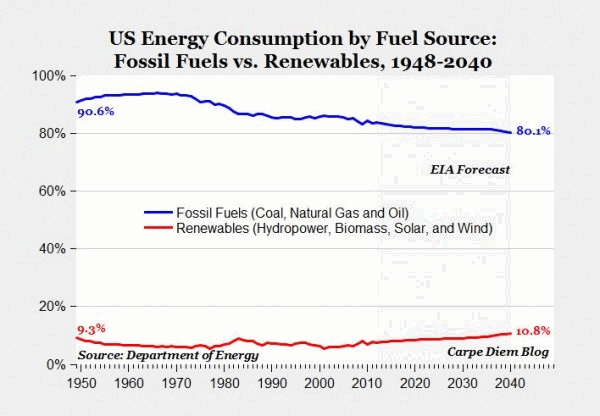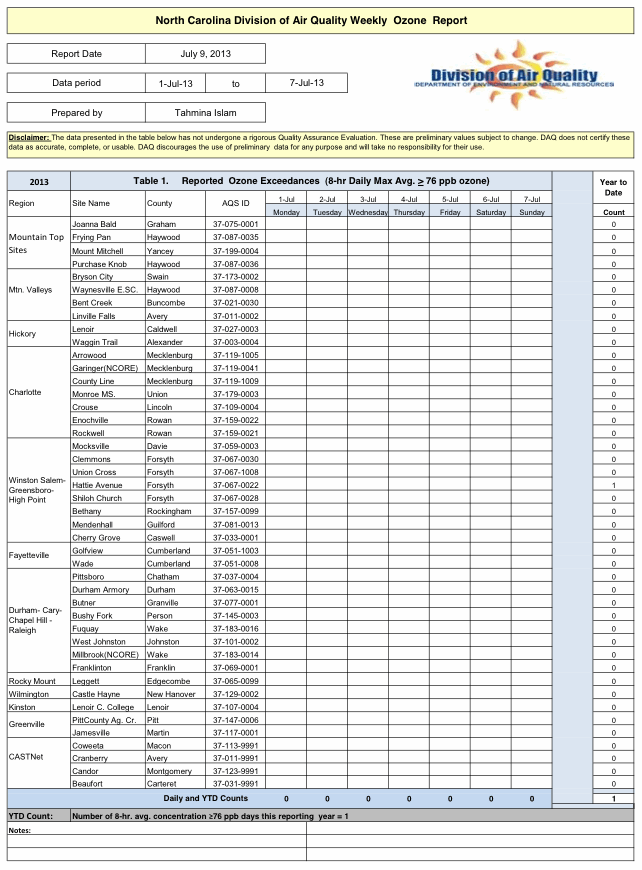Weekly John Locke Foundation research division newsletter focusing on environmental issues.
This newsletter highlights relevant analysis done by the JLF and other think tanks as well as items in the news.
1. Fossil fuels will continue to dominate for decades and beyond according to Obama’s DOE
Despite what President Obama has been telling us about how the corporate welfare sustained solar and wind power industries are the "energy sources of the future," his own Department of Energy is singing a different tune. The graph below, using DOE projections, tells the story. Despite all the job killing subsidies and coercive renewable energy programs like North Carolina’s Senate Bill 3, in 2040 fossil fuels will still be providing us with about 80% of our energy with renewables providing about 10%. This is just about what it is today. Writing for the American Enterprise Institute, University of Michigan economics professor Mark Perry, invoking DOE data, notes that:
Last year, fossil fuels provided almost 84% of America’s energy, which was nearly unchanged from the 85% fossil fuel energy share twenty years ago in the early 1990s. Even more than a quarter of a century from now in 2040, the Department of Energy forecasts that fossil fuels will still be the nation’s dominant energy source, providing more than 80% of our energy needs.
In other words, most renewable energy sources, particularly solar and wind power, are not economically viable and will continue to be unsustainable without taxpayer subsidies for the foreseeable future. In spite of this, legislatures, like North Carolina’s General Assembly, continue with economically destructive programs meant to prop up this desperate industry. Ultimately, there is only one logical explanation for this — special interest control of the legislative process. Once subsidies start flowing to an industry, they are almost impossible to eliminate, regardless of how nonsensical the subsidies are from the perspective of sound public policy. (I dealt with this issue in a previous newsletter.)

2. Ozone Report: Lowest number of ozone days in years at this point in the season
By the first week in July in 2012 various ozone (smog) monitors in North Carolina had registered a total of 104 high ozone days. By this same week in 2011 there had been 73 high ozone readings registered across the state. In 2010 there were 48. So far this year over this same period from April 1 through the first week in July, there has been 1. I have been studying North Carolina’s annual ozone data for nearly a dozen years now, and this is the fewest number that I have seen at this point in the season. As I noted last week, this doesn’t mean that the entire season will continue on this path. One very hot, very sunny week can change everything. But the facts at this point are remarkable. Given that I am an observer of the data and not a scientist, I will not venture an explanation other than to note that weather plays an important role in the formation of ozone, and this summer we have experienced a good number of rainy or overcast days. On the other hand, there have been other years where we have had similar weather without these kinds of results. Stay tuned to this newsletter as we will continue to keep track of the data over the course of the summer and into the fall.
According to current EPA standards a region or county experiences a high ozone day if a monitor in that area registers the amount of ozone in the air as 76 parts per billion (ppb) or greater. The official ozone season will end on October 31. All reported data is preliminary and issued by the North Carolina Division of Air Quality, which is part of the state’s Department of Environment and Natural Resources. During the period from July 1-7 there were no high-ozone days recorded.
The table below shows all of North Carolina’s ozone monitors and the number of high ozone days for the week and the year to date.



